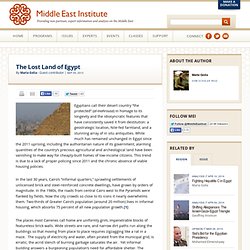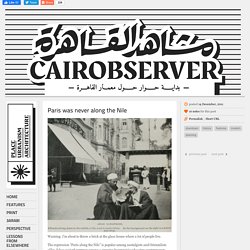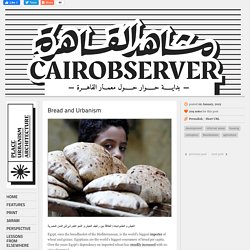

The Lost Land of Egypt. Egyptians call their desert country “the protected” (al-mahrousa) in homage to its longevity and the idiosyncratic features that have consistently saved it from destitution: a geostrategic location, Nile-fed farmland, and a stunning array of in situ antiquities.

While much has remained unchanged in Egypt since the 2011 uprising, including the authoritarian nature of its government, alarming quantities of the country’s precious agricultural and archeological land have been vanishing to make way for cheaply-built homes of low-income citizens. This trend is due to a lack of proper policing since 2011 and the chronic absence of viable housing policies.
In the last 30 years, Cairo’s “informal quarters,” sprawling settlements of unlicensed brick and steel-reinforced concrete dwellings, have grown by orders of magnitude. Letter from Cairo – LARB. “Why are we destroying our own city with our own hands?”

The architect Nairy Hampikian asked last month in Magaz, an Egyptian design magazine. Paris was never along the Nile. Warning: I’m about to throw a brick at the glass house where a lot of people live.

The expression “Paris along the Nile” is popular among nostalgists and Orientalists alike. It has gained currency among a growing bourgeoisie who view contemporary Cairo with discontent and find a fragment of its imagined past to be a redeeming escape only because it maybe referenced via Paris, the “capital of modernity.” Contemporary Orientalists also use the expression to further emphasize the notion that Europe, namely Paris, monopolized the very idea of 19th century urban modernity.
The straight boulevard is thus a Parisian invention and if one exists in Cairo or any other city, particularly non-European cities, then credit is due: “Thank you Paris, thank you Haussmann, what would our cities have become if it weren’t for you?” Numerous books and essays perpetuate the notion that 19th century Cairo was nothing more than mimicry, and a bad copy at that, of Paris. 1. 2. Where is Cairo headed? AUC Press - Understanding Cairo.
Political Life in Cairo’s New Quarters. Singerman - Cairo Contested. How David Sims Understands Cairo. 2050 Or Bust. David Sims' "Understanding Cairo" Abu-Lughod, J.L.: Cairo: 1001 Years of the City Victorious. Histories of a City: the many hands that shaped today's Cairo. One of Jean-Léon Gérôme's most famous Orientalist paintings, Prayer on the Rooftops of Cairo, is backwards.

The men in the scene are facing north in prayer, not south-east towards Mecca. Under the shadow of two Mamluk minarets with the mosque of Mohammed Ali in the distance, perched atop the Citadel, the Cairenes on the canvas pray just after sunset, with a sliver of the moon in the sky. It's an idyllic, invented scene that Gérôme, one of the most accomplished Orientalists of his day, painted in his studio in France, embellishing it to suit his viewers' desire for the exotic. Its inaccuracy was beside the point. This painting, like so many that Gérôme made in the late 19th century, captivated its European audience.
Nezar AlSayyad includes a large detail of this painting spread over two pages in Cairo: Histories of a City. Bread and Urbanism. العيش و العشوائيات: العلاقة بين رغيف العيش و النمو العمراني في المدن المصرية Egypt, once the breadbasket of the Mediterranean, is the world’s biggest importer of wheat and grains.

Egyptians are the world’s biggest consumers of bread per capita. Over the years Egypt’s dependency on imported wheat has steadily increased with no sign of reversal. Egypt’s population , currently 81 million, is growing at 2 percent a year. By 2025, its population could reach 104 million, and by 2050 it population could be close to 140 million, an increase of 70 percent.Rising population will mean less land available for agriculture, and if upstream usage of Nile river water increases, as appears likely, there could be less water for Egyptian farmers in the years ahead.
This population growth also means more need for housing, and more need for land to urbanize. CairObserver. Cairobserver is the start of a conversation about Cairo’s architecture and building, urban fabric and city life.

Cairo is one of the greatest cities in the world with a rich history and a fascinating contemporary condition that makes it an ideal site for urban and architectural investigation. Cairobserver is dedicated to presenting visitors and residents with lucid analysis, commentary and information about Cairo’s architecture and urbanism. Cairobserver also aims to confront stereotypical views of this city by enriching the ways in which professionals, students and residents understand the policies that shape the city.
The site also explores Cairo’s history and sites, its urban and architectural merits and the city’s many challenges. Additionally, Cairobserver aims to connect readers with the activism and grassroots action that attempt to engage with Cairo’s urban reality. Cairobserver is open for contributions. يرحب مشاهد القاهرة بالمساهمات.